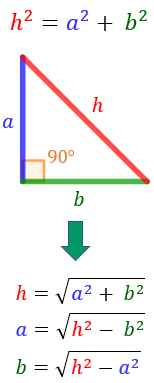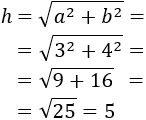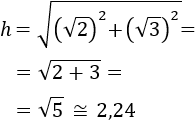Pythagorean Theorem

Pythagoren Theorem
Pythagoras' Theorem: Given a right triangle with sides a and b and a hypotenuse h (the side opposite the right angle). Then,

Remember that...
-
triangle is a right-angled triangle because it has a right angle, an angle of 90º or π / 2 radians
-
The hypotenuse is the opposite side as the right angle.
Note: h is always bigger than the other sides, as shows h > a and h > b.
The Pythagoras theorem is one of the most known results in mathematics and also one of the oldest known. There are hundreds of demonstrations of this theorem.
Applying Pythagorean Theorem
Example 1
Calculate the hypotenuse of the triangle with sides of 3cm and 4 cm.
The sides are
a = 3 cm, b = 4cm
Applying the Pythagoras Theorem,

Therefore, the hypotenuse measures 5cm.
Example 2
Calculate the hypotenuse of the right angled triangle that's sides are  and
and  .
.
We call the sides a and b, and the hypotenuse h (it doesn't matter which side we call a or b).
We know that

Using the Pythagoras theorem, we know that

We replace the known values in the equations (a and b), obtaining:

Remember that a square root squared is the radicand (what is inside the square root sign), so

Due to this, the hypotenuse measures approximately 2.24
We don't indicate a unit of measurement because the activity didn't provide one.
More examples: Pythagoras' Theorem.

Matesfacil.com by J. Llopis is licensed under a Creative Commons Attribution-NonCommercial 4.0 International License.



